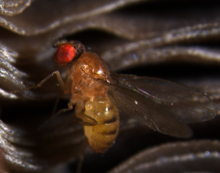| Drosophila testacea | |
|---|---|

| |
| A D. testacea male | |
| Scientific classification | |
| Domain: | Eukaryota |
| Kingdom: | Animalia |
| Phylum: | Arthropoda |
| Class: | Insecta |
| Order: | Diptera |
| Family: | Drosophilidae |
| Subfamily: | Drosophilinae |
| Genus: | Drosophila |
| Subgenus: | Drosophila |
| Species group: | testacea |
| Species: | D. testacea |
| Binomial name | |
| Drosophila testacea Grimaldi, James, and Jaenike, 1992 | |
Drosophila testacea is a member of the testacea species group of Drosophila. Testacea species are specialist fruit flies that breed on the fruiting bodies of mushrooms. Drosophila testacea can be found in temperate regions of Europe, extending to East Asia. Drosophila testacea and Drosophila orientacea can produce viable hybrids, though they are separated by geography and behavioural barriers. Drosophila testacea females will also readily mate with Drosophila neotestacea males, but viable hybrids are never produced. This hybrid inviability (see Haldane's rule)) may be due to selfish X chromosomes and co-evolved suppressors. Alternately, differences in sex pheromone (e.g. vaccenyl acetate) reception could underlie female readiness and male willingness to copulate.
The antimicrobial peptide gene Diptericin B has been pseudogenized in D. testacea and likely its sister species, D. neotestacea. This was due to a lack of Acetobacter bacteria in its environment, relaxing Natural selection on Diptericin B, which is specifically evolved to combat Acetobacter.
See also
References
- ^ Grimaldi, David; James, Avis C.; Jaenike, John (1992). "Systematics and Modes of Reproductive Isolation in the Holarctic Drosophila testacea Species Group (Diptera: Drosophilidae)" (PDF). Annals of the Entomological Society of America. 85 (6): 671–685. doi:10.1093/aesa/85.6.671.
- Keais, G. L.; Hanson, M. A.; Gowen, B. E.; Perlman, S. J. (2017). "X chromosome drive in a widespread Palearctic woodland fly, Drosophila testacea". Journal of Evolutionary Biology. 30 (6): 1185–1194. doi:10.1111/jeb.13089. PMID 28402000.
- Khallaf, Mohammed (2020). "Large-scale characterization of sex pheromone communication systems in Drosophila". BioRxiv. Archived from the original on 6 October 2020. Retrieved 4 October 2020.
- Hanson, Mark Austin; Lemaitre, Bruno; Unckless, Robert L. (2019). "Dynamic evolution of antimicrobial peptides underscores trade-offs between immunity and ecological fitness". Frontiers in Immunology. 10: 2620. doi:10.3389/fimmu.2019.02620. ISSN 1664-3224. PMC 6857651. PMID 31781114.
- Hanson, M. A.; Grollmus, L.; Lemaitre, B. (21 July 2023). "Ecology-relevant bacteria drive the evolution of host antimicrobial peptides in Drosophila". Science. 381 (6655). doi:10.1126/science.adg5725. hdl:10871/133708. ISSN 0036-8075.
| Taxon identifiers | |
|---|---|
| Drosophila testacea |
|